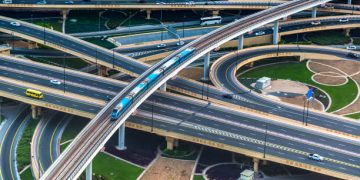Dubai has recorded an average of over 1.8 million daily users of its public transport services during the first eight months of 2023. From January to August, public transport ridership reached 450 million passengers, representing a 12% increase from the 401 million passengers reported in the same period in 2022. The Dubai Metro emerged as the most popular mode of transportation, serving 167 million riders. Taxis followed with 130 million users, while public buses transported 111 million riders. Marine transport accounted for 11 million passengers, and the Dubai Tram served 5.6 million. Additionally, shared transportation options, including e-hail services, smart rentals, and bus-on-demand, catered to approximately 26 million passengers.
These statistics were released by the Roads and Transport Authority (RTA) as it prepares to celebrate its 18th anniversary and the 14th Public Transport Day initiative on November 1. The event, themed ‘Gym on the Go,’ aims to promote physical fitness and encourage residents and visitors to utilize public transportation. Mattar Al Tayer, the director-general and chairman of the RTA, noted that the share of mass transport in people’s mobility has increased from 6% in 2006 to 20.61% in 2022.
The RTA highlighted that Dubai’s interconnected public transport system has become essential for mobility throughout the Emirate. Over the years, the RTA has undertaken various large-scale projects valued at approximately Dh146 billion, including the Dubai Metro—the world’s longest driverless metro system, spanning 89.3 km; the 11 km-long Dubai Tram; a fleet of 1,400 buses; and marine transport options featuring traditional Abras, ferries, and water taxis.
Between 2006 and 2022, Dubai’s road network expanded from 8,715 to 18,768 lane-km, and the number of bridges and tunnels increased from 129 to 988. During this same period, the quantity of footbridges and subways, including facilities for the Dubai Metro and Tram, grew from 26 to 122. Cycling lanes have also seen substantial growth, increasing from 9 km to 543 km, with plans to reach 833 km by 2026.
In line with sustainability efforts, the RTA announced its ‘Zero-Emissions Public Transportation in Dubai 2050’ strategy in May. This initiative aims to address climate change impacts and reduce the carbon footprint of public transport operations, with plans to convert 100% of public buses to electric and hydrogen power by 2050 and to transition taxis and limousines to similar vehicles by 2040.
The latest in supply chain logistics news is now on The Supply Chain Report. Visit ADAMftd.com for free tools related to international trade.
#DubaiTransport #PublicTransport #Sustainability #TransportationNews #SmartCities

















